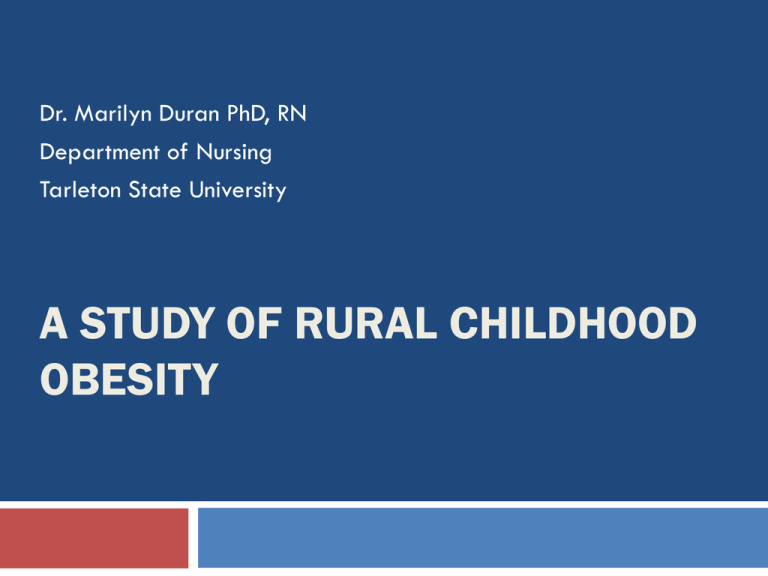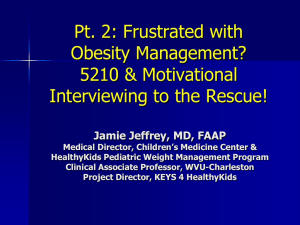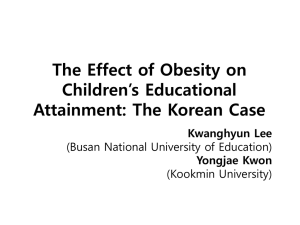
Dr. Marilyn Duran PhD, RN
Department of Nursing
Tarleton State University
A STUDY OF RURAL CHILDHOOD
OBESITY
Childhood Overweight and Obesity
Children and teens (2–19 years)16.9%
obese: ~12.5 million
(http://www.cdc.gov/obesity/childhood/index.html)
Childhood Obesity Trends
The Impact of Obesity
In some communities, almost half of pediatric diabetes
cases are type 2 diabetes, which was once believed
to affect only adults.
Obese children have a 70% chance of being
overweight or obese as adults—facing higher risks
for many diseases, such as heart disease, diabetes,
stroke, and several types of cancers.
Source-http://www.cdc.gov/HealthyYouth/keystrategies/pdf/make-a-difference.pdf
The Burden of Childhood Obesity in Texas
∙Sixteen percent of Texas youth (9th–12th grades) are
overweight, and another 16% are obese, according to 2007
Youth Risk Behavior Survey data.
∙Only 45% of the youth in these grade levels are meeting current
physical activity recommendation levels.
∙Only 17% eat fruits and vegetables five or more times a day.
Thirty-eight percent drink at least one non-diet soda each day.
Almost 40% watch three or more hours of television each day.
Source-http://www.cdc.gov/obesity/stateprograms/fundedstates/texas.html
Background of Study
Current research data is lacking in the
comparison of rural verses urban childhood
obesity incidence and prevalence .
Most of childhood obesity rates are reported on
children living in urban areas.
Purpose of this study is to identify prevalence of
childhood obesity in rural school age children.
Study Description
The study began in spring of 2010 and is currently
ongoing and will continue in the spring of 2011.
Internal Review Board for the protection of human
subjects (IRB) approval received from Tarleton State
University (TSU).
Rural schools in Erath county and adjacent Hood
county participated in the study.
School age children ages grades K-9th grade
included.
Consent of parent required.
Study Funding
TSU department of sponsored projects provided funds
to purchase a digital scale that measures height,
weight and body mass index(BMI) , 2 skin calipers
and several hundred tee shirts.
Students were given a tee shirt as an incentive to
participate in the study.
Only students with a signed parental consent form
were allowed to participate in the study.
Study Methods/Materials
Senior level nursing students trained as data
collectors.
Students trained in the use of the scale and skin
calipers.
Older children completed a questionnaire about their
amount of physical activity.
Weight and height measurements were obtained.
BMI calculated based on gender specific age
percentiles.
Defining Childhood Overweight and Obesity
∙Body mass index (BMI) is a practical measure used to
determine overweight and obesity.
∙BMI is a measure of weight in relation to height that is
used to determine weight status.
∙BMI is the most widely accepted method used to screen
for overweight and obesity in children and
adolescents because it is relatively easy to obtain the
height and weight measurements needed to calculate
∙BMI, measurements are non-invasive and BMI
correlates with body fatness.
∙While BMI is an accepted screening tool for the initial
assessment of body fatness in children and
adolescents, it is not a diagnostic measure because
BMI is not a direct measure of body fatness.
Source: Center for Disease Control and Prevention-http://www.cdc.gov/healthyweight/assessing/bmi/childrens_bmi/about_childrens_bmi.html
What is a BMI percentile?
After BMI is calculated for children and teens, the BMI
number is plotted on the CDC BMI-for-age growth
charts (for either girls or boys) to obtain a percentile
ranking. Percentiles are the most commonly used
indicator to assess the size and growth patterns of
individual children in the United States.
The percentile indicates the relative position of the
child's BMI number among children of the same sex
and age. The growth charts show the weight status
categories used with children and teens (underweight,
healthy weight, overweight, and obese).
Source: Center for Disease Control and Preventionhttp://www.cdc.gov/healthyweight/assessing/bmi/childrens_bmi/about_childrens_bmi.html
BMI-for-age weight status categories
and the corresponding percentiles.
Weight Status Category Percentile Range
∙Underweight Less than the 5th percentile.
∙Healthy weight 5th percentile to less than the 85th
percentile.
∙Overweight 85th to less than the 95th percentile.
∙ Obese Equal to or greater than the 95th percentile.
Source: Center for Disease Control and Preventionhttp://www.cdc.gov/healthyweight/assessing/bmi/childrens_bmi/about_childrens_bmi.html
Preliminary Findings
K-2nd grade
●112 children ages 5-7yrs
●Obese-25 (22.3%)
●Overweight – 19 (16.9%)
●Obese & Overweight-44 (39.2%)
●Hispanic- 13.3%
●White- 86.7%
Preliminary Findings
Middle School
●6-8th grades
●191 children and adolescents ages 11-15yrs
●Obese-50 (26.1%)
●Overweight-28 (14.6%)
●Obese & Overweight- 78 (40.7%)
●Hispanic- 29.4%
●White- 70.6%
Preliminary Finding
●9th grade only
● 219 Adolescents 14-16 yrs
●Obese-57 (26%)
●Overweight- 41(18.7%)
●Obese & Overweight- 98 (44.7%)
●Hispanic- 16.3%
●White- 83.7%
Discussion of Preliminary Findings
These findings suggest that rural school age children
may experience obesity prevalence at higher rates
than current CDC estimates.
These are only preliminary findings and do not prove
a relationship or causation.
When study is completed final sample should exceed
over 1000 rural school age children.
Conclusion
After study is completed the data will be used to
identify rural childhood obesity prevalence and
gain understanding of the significance of the
problem in rural communities.
Plan is to work with schools, parents, healthcare
providers and community members to identify and
develop collaborative programs at the community
level to reduce rural childhood obesity prevalence
thereby improving the health of rural children.









